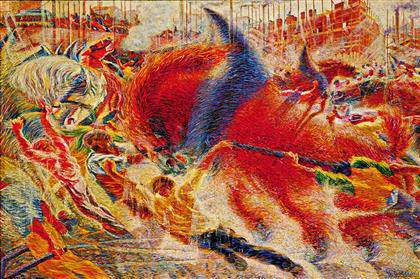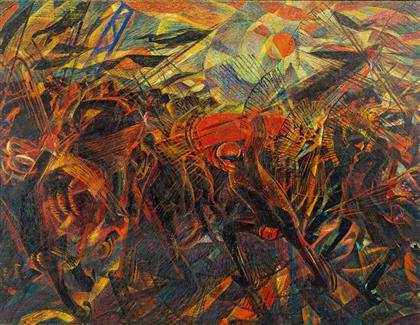
Umberto Boccioni, The City Rises (La città che sale), 1910–11.
Oil on canvas, 199.3 x 301 cm.
The Museum of Modern Art, New York
Mrs. Simon Guggenheim Fund, 1951.
Digital image © The Museum of Modern Art
Licensed by SCALA/Art Resource, New York

Carlo Carrà, Funeral of the Anarchist Galli
(Funerali dell’anarchico Galli), 1910–11.
Oil on canvas, 198.7 x 259.1 cm.
The Museum of Modern Art, New York
Acquired through the Lillie P. Bliss Bequest, 1948
© 2014 Artists Rights Society (ARS), New York/SIAE, Rome.
Digital image © The Museum of Modern Art
Licensed by SCALA/Art Resource, New York
Italian Futurism, 1909–1944: Reconstructing Universe From February 21 through September 1, 2014, the Guggenheim Museum presents ‘Italian Futurism, 1909–1944: Reconstructing the Universe’, the first comprehensive overview in the U.S. of one of Europe’s most important 20th-century avantgarde movements.]]>
Source: Solomon R. Guggenheim Museum
Featuring over 360 works by more than 80 artists, architects, designers, photographers, and writers, this multidisciplinary exhibition examines the full historical breadth of Futurism, from its 1909 inception with the publication of Filippo Tommaso Marinetti’s first Futurist manifesto through its demise at the end of World War II. The exhibition includes many rarely seen works, some of which have never traveled outside of Italy. It encompasses not only painting and sculpture, but also the advertising, architecture, ceramics, design, fashion, film, free-form poetry, photography, performance, publications, music, and theater of this dynamic and often contentious movement that championed modernity and insurgency.
“Italian Futurism” begins with an exploration of the manifesto as an art form, and proceeds to the Futurists’ catalytic encounter with Cubism in 1911, their exploration of near-abstract compositions, and their early efforts in photography. Ascending the rotunda levels of the museum, visitors follow the movement’s progression as it expanded to include architecture, clothing, design, dinnerware, experimental poetry, and toys. Along the way, it gained new practitioners and underwent several stylistic evolutions—shifting from the fractured spaces of the 1910s to the machine aesthetics (or arte meccanica) of the ’20s, and then to the softer, lyrical forms of the ’30s. Aviation’s popularity and nationalist significance in 1930s Italy led to the swirling, often abstracted, aerial imagery of Futurism’s final incarnation, aeropittura. This novel painting approach united the Futurist interest in nationalism, speed, technology, and war with new and dizzying visual perspectives. The fascination with the aerial spread to other mediums, including ceramics, dance, and experimental aerial photography.
The exhibition is enlivened by three films commissioned from documentary filmmaker Jen Sachs, which use archival film footage, documentary photographs, printed matter, writings, recorded declamations, and musical compositions to represent the Futurists’ more ephemeral work and to bring to life their words-in-freedom poems.
“Italian Futurism” concludes with the five monumental canvases that compose the “Syntheses of Communications” (1933–34) by Benedetta (Benedetta Cappa Marinetti), which are being shown for the first time outside of their original location. One of few public commissions awarded to a Futurist in the 1930s, the series of paintings was created for the Palazzo delle Poste (Post Office) in Palermo, Sicily. The paintings celebrate multiple modes of communication, many enabled by technological innovations, and correspond with the themes of modernity and the “total work of art” concept that underpinned the Futurist ethos.
Related content
Chaos and Classicism: European Art, 1918–1936, at the Guggenheim Bilbao (exhibition, 2011)
Follow us on:


